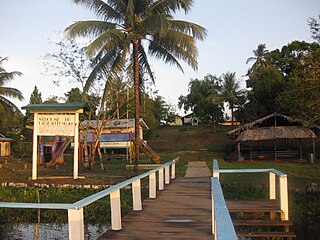
Barima-Waini is a region of Guyana and is located in the northwest of the country. Barima-Waini has three sub-regions: Mabaruma, Matakai, and Moruca.

Port Kaituma is a small village within the Barima-Waini administrative region of Guyana. It became known internationally as a gateway village to the Peoples Temple settlement in nearby Jonestown. It has long been a hub for mining in the area.

Potaro-Siparuni is a region of Guyana. It borders the region of Cuyuni-Mazaruni to the north, the regions of Upper Demerara-Berbice and East Berbice-Corentyne to the east, the region of Upper Takutu-Upper Essequibo to the south and Brazil to the west.
The Moruka River or Moruca River is a river in the Barima-Waini region of northern Guyana.

Kaieteur National Park is a national park located in the Potaro-Siparuni Region of Guyana, roughly 633 km south of Georgetown, the nation's capital, closer to the border with Brazil than to the Caribbean coast. It is widely considered the country's only national park, as the capital's National Park is a not a true wilderness reserve. Kaieteur is part of the Guianan moist forests ecoregion. The main tourist attraction in the park is Kaieteur Falls, considered the largest single-drop waterfall anywhere on earth, by volume of water. Orinduik Falls is another water-feature in the park, a series of smaller, cascading waterfalls. There is a popular swimming hole located at Orinduik.

The Guyana Defence Force (GDF) is the military of Guyana, established in 1965. It has military bases across the nation. The Commander-in-Chief of the Defence Force is always the incumbent President of Guyana.

Ankoko Island is an island located at the confluence of the Cuyuni River and Wenamu River, at 6°43′N61°8′W, on the border between Venezuela and Guyana.

The Orinduik Falls lie on the Ireng River, a highland river that thunders over steps and terraces of red jasper on the border of Guyana and Brazil before merging with the Takutu River and into Brazil to join the Amazon River.

Kabakaburi is an Amerindian village in the Pomeroon-Supenaam Region of Guyana on the Pomeroon River, 56 km (35 mi) from its mouth. The village was founded in 1845 by William Henry Brett on the location where Fort Durban used to be.

Paramakatoi is an Amerindian community in the Potaro-Siparuni Region of Guyana, located in the Pacaraima Mountains. With an altitude of 970 metres (3,180 ft), it is 18 kilometres (11 mi) east of Kurukabaru.

The Akawaio are an indigenous people who live in Roraima (Brazil), Guyana, and Venezuela. They are one of several closely related peoples called Ingarikó and Kapon. The Akawaio language is used by 5,000 to 6,000 speakers.
Bethany Village is a mission located on the Araburia River, a tributary three miles up the Supenaam River in Pomeroon-Supenaam, Essequibo in Guyana.
Telecommunications in Guyana include radio, television, fixed and mobile telephones, and the Internet. Early telecommunications were owned by large foreign firms until the industry was nationalized in the 1970s. Government stifled criticism with a tight control of the media, and the infrastructure lagged behind other countries, Guyana Telephone and Telegraph Company (GT&T) holding a monopoly on most such services. In a 2012 census report on Guyanese households, 55.5% had a radio, 82.7% had a television, 27.8% had a personal computer, and 16.2% had internet at home, 49.3% had a telephone landline, and 70.6% had a cellular phone.
The Ekareku River is a river of Guyana, a tributary of the Wenamu River.
Sophia is a ward of Georgetown, the capital of Guyana. It's a predominantly Afro-Guyanese community, and one of Georgetown's poorest neighborhoods.
The COVID-19 pandemic in Guyana was a part of the worldwide pandemic of coronavirus disease 2019 caused by severe acute respiratory syndrome coronavirus 2. The virus was confirmed to have reached Guyana on 11 March 2020. The first case was a woman who travelled from New York, a 52-year-old woman with underlying health conditions, including diabetes and hypertension. The woman died at the Georgetown Public Hospital.
Morawhanna is a small Atlantic coast village in Guyana, on the left side of the Barima River and in close proximity to Venezuela.
Pickersgill is a village in the Pomeroon-Supenaam of Guyana. It is located near the Pomeroon River.
Isseneru is an Amerindian settlement in the Cuyuni-Mazaruni region of Guyana, approximately 15–20 miles west of Kurupung.










